In part 1 of a series, Dr. S. Jay Bowman explores instruments that help increase the utility of aligners and expand the scope of appropriate applications
Let’s be clear: enhancing aligner treatments
As clear aligner treatments have evolved and been progressively refined in the past 15 years, more advanced applications and increasingly complex malocclusions have been addressed.1-4 In addition, there has been more interest in tackling some of the specific limitations of moving teeth with plastic.5-7 Obviously, the progress of orthodontic treatment with traditional wires and braces has been advanced throughout the past century, but the techniques associated with a sequence of aligners are relatively recent phenomena.
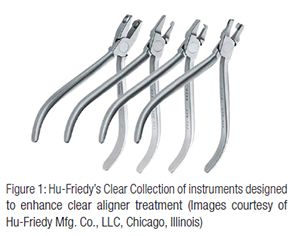 Orthodontists with the most experience and enthusiasm in using aligners have worked diligently to improve the concept through better understanding of the limitations involved in more advanced treatment planning, especially when using adjuncts to enhance the associated biomechanics.4,8-13 The Clear Collection of instruments from Hu-Friedy (Chicago, Illinois, at www.hu-friedy.com) was developed with that aim in mind; namely, to help to increase the utility of aligners and expand the scope of appropriate applications (Figure 1).13
Orthodontists with the most experience and enthusiasm in using aligners have worked diligently to improve the concept through better understanding of the limitations involved in more advanced treatment planning, especially when using adjuncts to enhance the associated biomechanics.4,8-13 The Clear Collection of instruments from Hu-Friedy (Chicago, Illinois, at www.hu-friedy.com) was developed with that aim in mind; namely, to help to increase the utility of aligners and expand the scope of appropriate applications (Figure 1).13
Adding intra- and intermaxillary forces
The Clear Collection instruments have streamlined and standardized some procedures that orthodontists had already been providing, while opening up more options for other methods to accentuate or refine treatment. In the past, attempting to add intermaxillary elastics for correction of Class IIs, IIIs, or midlines was problematic. Some were cutting notches in plastic trays using scissors or nail clippers10 or attempting to adhere buttons to the trays — all unwieldy endeavors.
The Tear Drop
There are occasions when orthodontic elastics are needed to assist with specific tooth movements or growth modification when using aligners. For instance, it may be beneficial to add elastic hooks or bonded buttons in different locations along the arch form on either the buccal or lingual. It would be beneficial to incorporate an elastic hook that cannot be dislodged from the aligner and that only requires a simple one-step squeeze of a pair of pliers to create. Most importantly, a hook that actually holds the elastic in place on the aligner.
The Tear Drop pliers (Figure 2) is an instrument created for the purpose of adding a notch or hook at the gingival margin of clear aligners. A standardized notch is easily cut in a single step, creating a teardrop-shaped “reservoir” to hold the elastic on the tray (Figure 3), thereby making it easier for the patients to seat their aligner and connect their elastics. In this manner, the patient is not fumbling with elastics, attempting to hook them in two locations since the elastic accompanies the aligner as it is seated over the teeth.
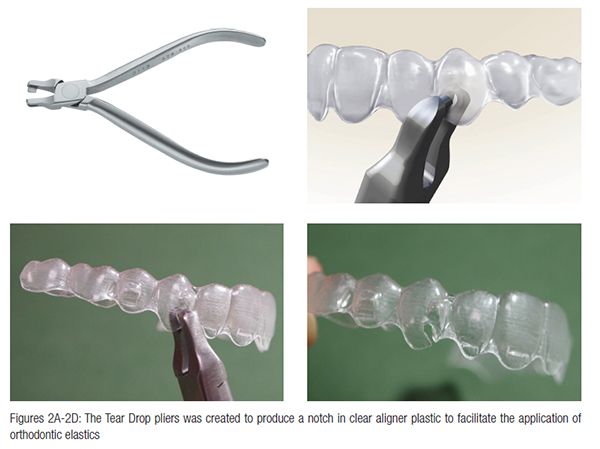 Teardrop notches should be cut at an angle to resist the line of force of elastics that are being employed (e.g., the notch is angled anteriorly at the mesial of the upper cuspid for Class II elastics; Figure 3). These hooks can be added anywhere along the clear aligner arch at the gingival margin on either the facial or lingual, whenever elastic forces need to be applied.
Teardrop notches should be cut at an angle to resist the line of force of elastics that are being employed (e.g., the notch is angled anteriorly at the mesial of the upper cuspid for Class II elastics; Figure 3). These hooks can be added anywhere along the clear aligner arch at the gingival margin on either the facial or lingual, whenever elastic forces need to be applied.
 The Hole Punch
The Hole Punch
The Hole Punch (Figure 4) is used to cut a half-moon shaped hole at the gingival margin of aligners. These half-circle cuts permit the addition of bonded buttons, bonded orthodontic tubes or brackets with associated hooks, or are simply used to relieve impingement of plastic on soft tissue. The Hole Punch can be used to produce cuts on either the facial or lingual of any tooth, anywhere along the aligners, whenever needed. Buttons bonded to teeth, rather than to the trays, do not cause dislodgement of the aligner.

During the progress of some patients’ treatments (after a series of aligners has already been fabricated and delivered), an orthodontist may wish to add elastics. Bonded buttons can be added to hook up Class II or III intermaxillary elastics, bite-seating elastics, Class I intramaxillary elastics to miniscrews (Figure 5), or elastomeric chain connected to buttons to correct dental rotations. The combination of buttons on molars (plastic relieved using the Hole Punch) along with elastic hooks cut into the plastic at the cuspids (using the Tear Drop) is a common method of employing orthodontic elastics.
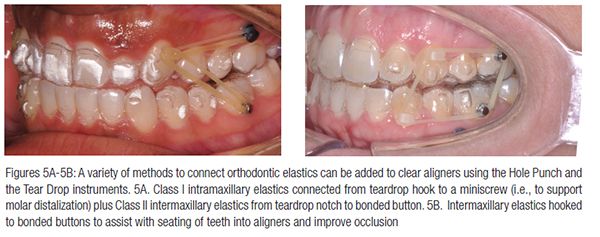 In other instances, aligners will occasionally impinge upon gingival tissues and cause gingival pain or inflammation. The Hole Punch can be used to clear the impingement of plastic in each of a series of aligners. A common location for that type of irritation is at the incisive papilla, behind the maxillary central incisors (Figure 6). Nipping along the gingival margin of a tray with the Hole Punch is also an option to relieve marginal gingival impingement on either the buccal or lingual.
In other instances, aligners will occasionally impinge upon gingival tissues and cause gingival pain or inflammation. The Hole Punch can be used to clear the impingement of plastic in each of a series of aligners. A common location for that type of irritation is at the incisive papilla, behind the maxillary central incisors (Figure 6). Nipping along the gingival margin of a tray with the Hole Punch is also an option to relieve marginal gingival impingement on either the buccal or lingual.
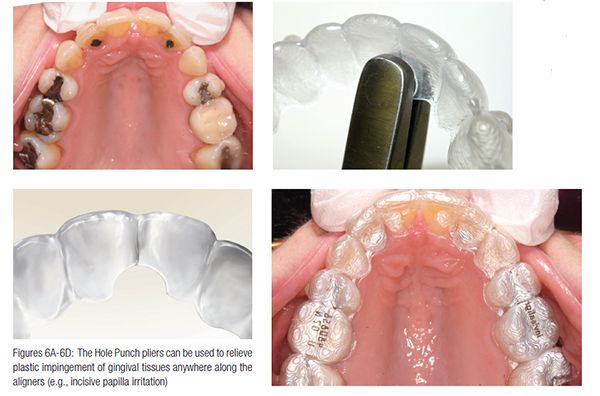 Bootstrap mechanics
Bootstrap mechanics
If certain teeth are not “tracking” or are lagging13 behind (i.e., not fitting into the tray; Figure 7) Aligner Chewies™ are employed (Chewies™ Aligner Tray Seaters, Dentsply Raintree Essix, York, Pennsylvania). Patients are asked to hold the Chewie between the teeth in question and squeeze 10-15 seconds, release, and repeat for 5 minutes, 2-3 times per day8,13 (Figure 8).

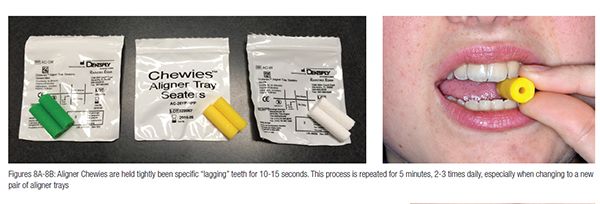 In addition, Chewies are routinely used for the first few days when patients switch to a new pair of aligners to help them seat more completely.
In addition, Chewies are routinely used for the first few days when patients switch to a new pair of aligners to help them seat more completely.
Another option is to add elastics to forcibly erupt the teeth into the aligner tray.13,14 There are several methods to generate so-called “bootstrap mechanics” (Figure 9):13
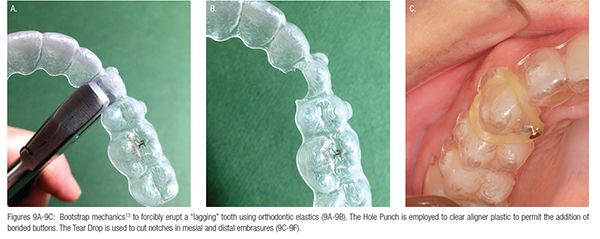 An orthodontic elastic is stretched over the plastic aligner to connect to a combination of bonded buttons on both lingual and buccal of the tooth.
An orthodontic elastic is stretched over the plastic aligner to connect to a combination of bonded buttons on both lingual and buccal of the tooth.
A bonded button is placed on the lingual of the tooth (plastic cleared with the Hole Punch). The Tear Drop notches are cut into the tray at the gingival embrasure spaces in the buccal plastic on both the mesial and distal of the problematic tooth, and an elastic hooked from the buccal notches and stretched over the aligner tray to the button to produce an extrusive force.13
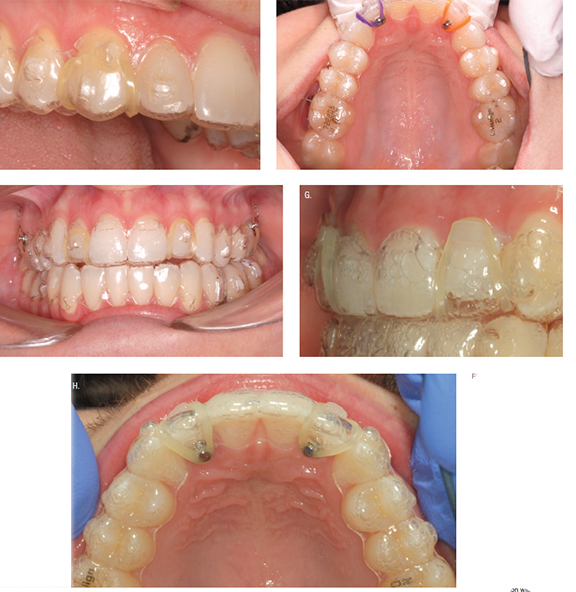
The Tear Drop and/or Hole Punch cuts are made in each tray in the series of aligners prior to their being delivered to the patient. This concept is also useful when the extrusion of a tooth is needed for restorative purposes.
Other biomechanics that benefit from the application of elastic forces to aligner trays include the correction of severe rotations, posterior or anterior intrusion mechanics for open bites,11,12 and forces to control anchorage during molar distalization or en masse movements when employing miniscrews (Figure 5).13 Cutting notches and relieving the plastic to add buttons or brackets facilitate the application of these innovative mechanics.
It is important to remember that in-discriminate alteration of the integrity of clear aligners may reduce their structural strength or may impair the intended biomechanics programmed into an aligner.
The instruments in the Clear Collection help the orthodontist to better customize clear aligner treatments, enhance their desired biomechanics, and streamline the addition of adjunctive forces during the course of a series of aligners. For information on the use and applications of the Clear Collection, instructional videos are available on YouTube at https://www.youtube.com/watch?v=hrs2VfnImLY.
References
1. Clements KM, Bollen AM, Huang G, King G, Hujoel P, Ma T. Activation time and material stiffness of sequential removable orthodontic appliances. Part 2: Dental improvements. Am J Orthod Dentofacial Orthop. 2003;124(5):502-508. 2. Djeu G, Shelton C, Maganzini A. Outcome assessment of Invisalign and traditional orthodontic treatment compared with the American Board of Orthodontics objective grading system. Am J Orthod Dentofacial Orthop. 2005;128(3):292-298. 3. Phan X, Ling PH. Clinical limitations of Invisalign. J Can Dent Assoc. 2007;73(3):263-266. 4. Tuncay O. The Invisalign System. London: Quintessence Publishing; 2007. 5. Kravitz ND, Kusnoto B, BeGole E, Obrez A, Agran B. How well does Invisalign work? A prospective clinical study evaluating the efficacy of tooth movement with Invisalign. Am J Orthod Dentofacial Orthop. 2009;135(1):27-35. 6. Krieger E, Seiferth J, Marinello I, Jung BA, Wriedt S, Jacobs C, Wehrbein H. Invisalign® treatment in the anterior region: were the predicted tooth movements achieved? J Orofac Orthop. 2012;73(5):365-376. 7. Chisari JR, McGorray SP, Nair M, Wheeler TT. Variables affecting orthodontic tooth movement with clear aligners. Am J Orthod Dentofacial Orthop. 2014;145(4 suppl):S82-91. 8. Tuncay O. Clinical Reports & Techniques. 2005;6(2):1. 9. Daher S. Techniques for Class II correction with Invisalign and elastics. Align Technology, Inc. Web site. Published 2013. Accessed April 11, 2015]. https://s3.amazonaws.com/learn-invisalign/docs/06840000000GHgmAAG.pdf 10. Paquette D. Temporary Anchorage Devices in Combination with Aligners 2009. Invisalign Web site. https://www.aligntechinstitute.com/files/ATEArchive/pdf/ate_110609.pdf 11. Boyd R. How successful is Invisalign for treatment of anterior open bite and deep overbite? Presented at: American Association of Orthodontists Annual Session; May 5, 2013; Philadelphia, PA. https://www.aaoinfo.org/system/files/media/documents/Boyd,%20Robert%20--%20Treatment%20of%20Deep%20and%20Open%20bite%20with%20Clear%20Aligners.pdf 12. Dayan, W. Techniques for Posterior Intrusion with Invisalign to Correct Anterior Open Bites. Techniques White Paper 2010. https://www.cityortho.ca/Portals/0/City%20Ortho-%20Open%20Bite%20Blog.pdf. 13. Bowman SJ, Celenza F, Sparanga J, Papadopoulos MA, Ojima K, Lin J. Creative adjuncts for clear aligners, Part 1: Class II treatment. J Clin Orthod. 2015;49(2):83-94. 14. Giancotti A, Ronchin M. Pre-restorative treatment with the Invisalign system. J Clin Orthod. 2006;40(11):679-682.
Stay Relevant With Orthodontic Practice US
Join our email list for CE courses and webinars, articles and mores


